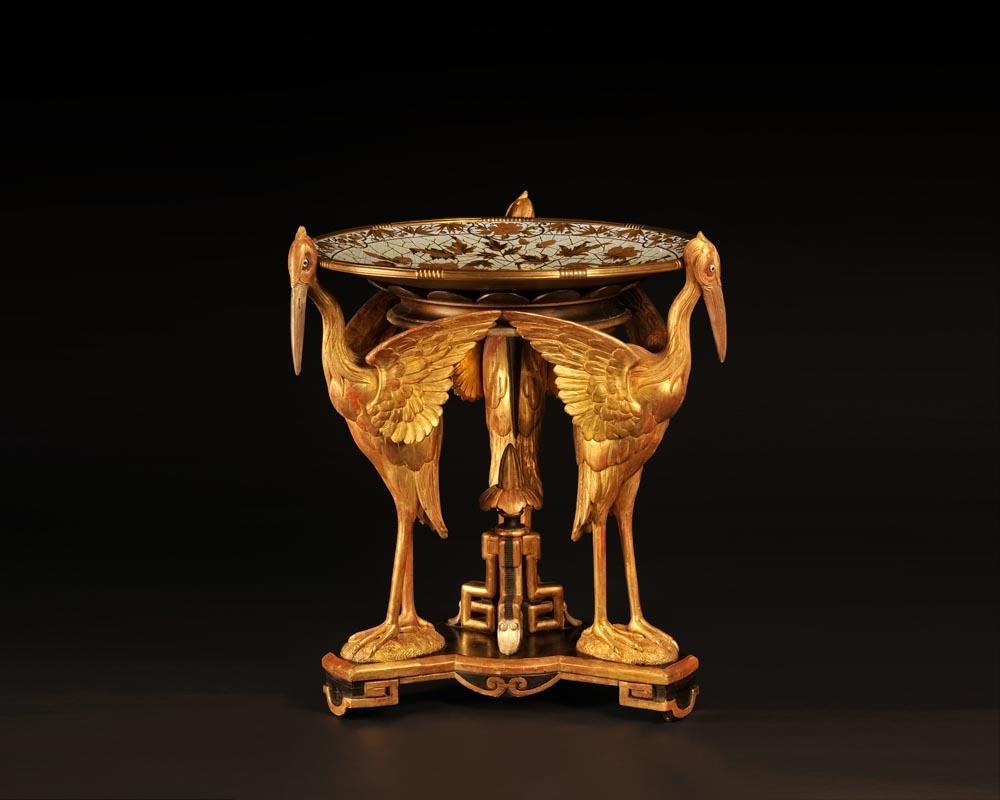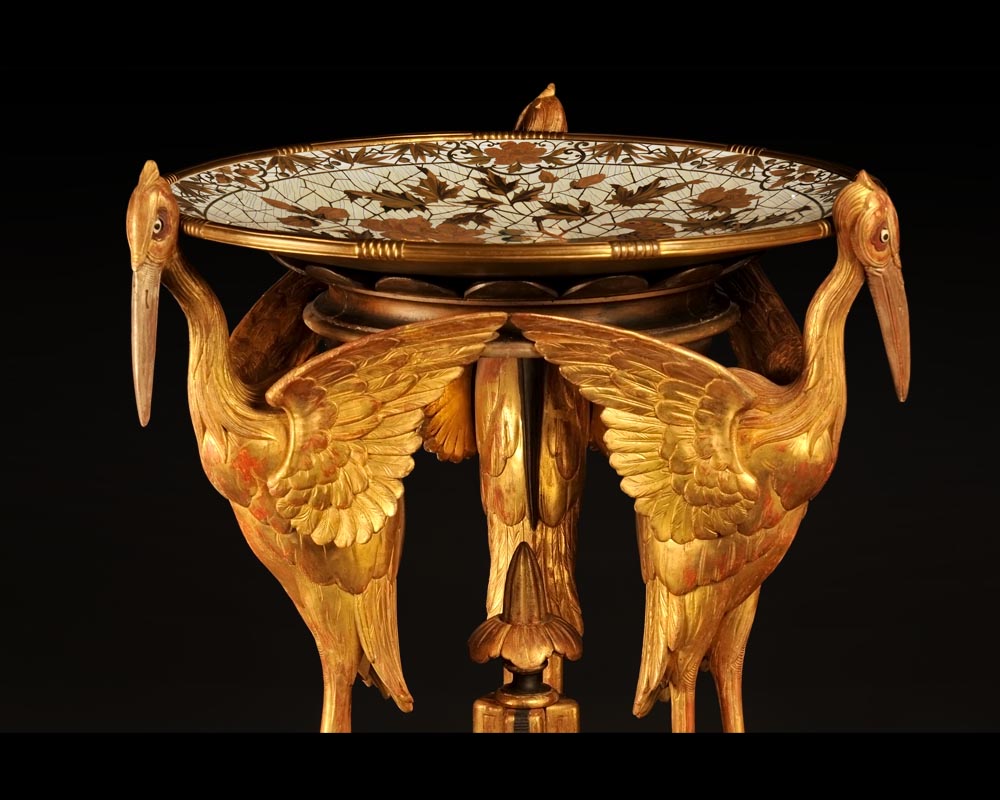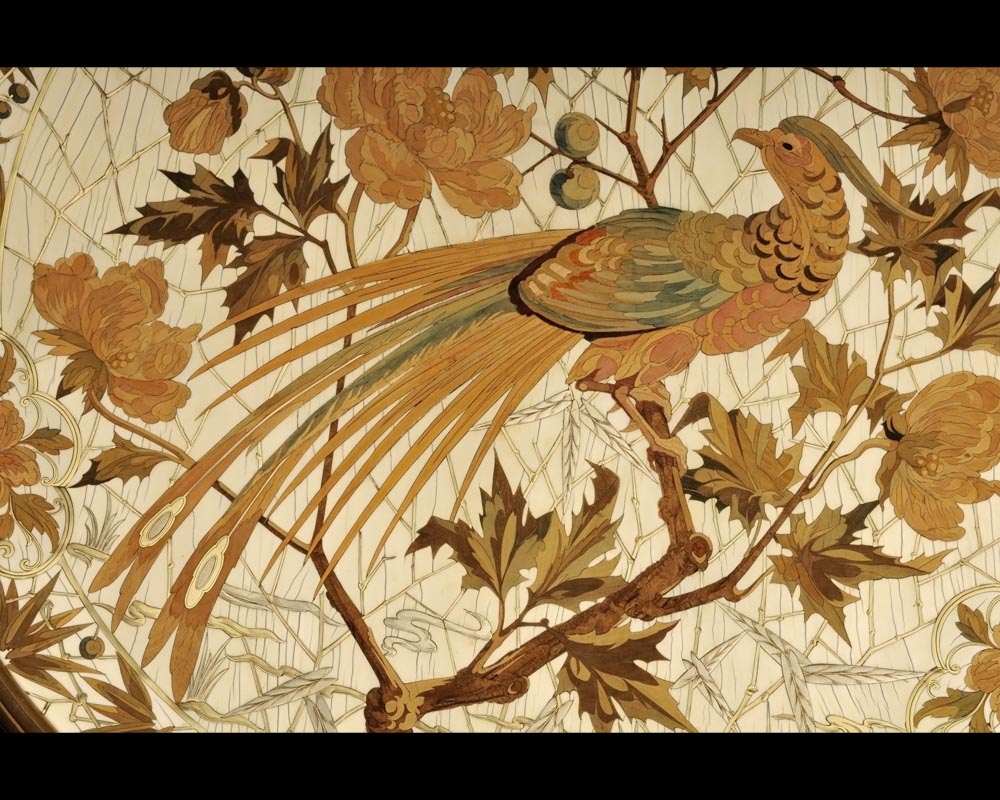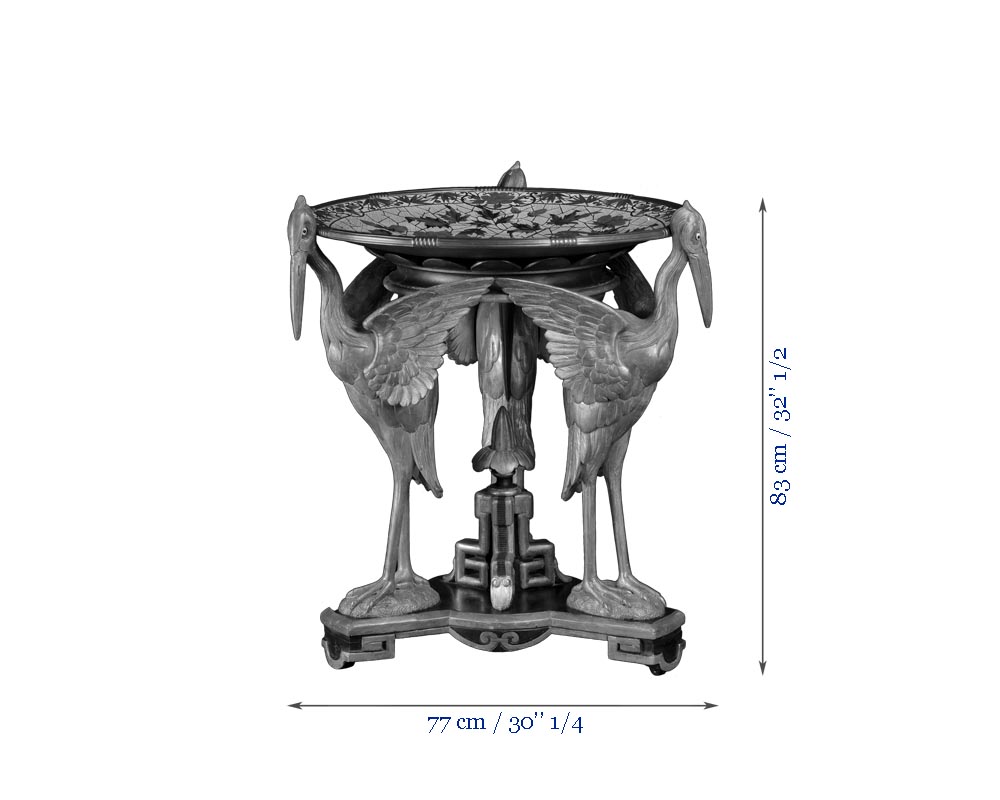Style Japonism, Chinoiserie / Ref.17226
Pierre-Ferdinand DUVINAGE (1823-1876), Exceptional Ivory Cloisonné Three-legged Pedestal Table Known as “The Large Cranes”
Dimensions
Width 30'' ¼ 77cm
Height 32'' ⅝ 83cm
Origin:
Date: 1874-1876
Ivory, gilt-bronze, silver, copper, marquetry in various exotic woods. Pedestal in gilded and silvered wood with polychrome.
Size: Height, 83 cm; Diameter, 77 cm.
Monogrammed “FD Bté” on the ivory and stamped “Alph Gir
This extraordinary pedestal table, signed by Pierre-Ferdinand Duvinage, is ornamented with an exceptionally well conceived decoration that highlights the naturalism of its theme. It is clearly inspired by Japan, a country that had opened its doors to the West and whose decorative repertory was very much appreciated. It also took its inspiration from earlier styles to create an eclectic piece of furniture that is a typical example of the decorative arts during the second half of the 19th century.
Three cranes are placed around a Japanese-inspired pedestal that support the top tray and is decorated using the technique invented and patented by Duvinage, in 1874. This entailed “the banding together of ivory, as the background, and wood – dyed or of the exotic type – for the designs or ornaments, along with copper or other metal to partition the ivory pieces.” In this work, entirely created by Duvinage, the eyes of the cranes, in ivory and ebony, evoke the hues of the top tray and emphasize the extraordinary unity of the work’s design. The French makers of exceptional pieces of cabinetry were recognized for their superiority in the area of furniture making. The jury at the International Exhibition of 1855 stressed that “France [...] is without rival wherever industry is united with the realm of art and this truth certainly finds its just and complete application in furnishings and decoration.”
The top of the table is decorated with a pheasant set on an ivory background and is executed in cloisonné; its partitioning is made of metal filaments. The bird rests on a branch whose flowers and foliage are crafted in great detail with much naturalism inspired by stylized Japanese branch work. The theme of a pheasant is found again, with some variations, on other works by Duvinage, such as the bowl conserved at the Detroit Art Institute. There is only one other known example of this pedestal table, today in a private collection, and it also has the crane legs supporting the top tray with pheasant motif; the design, however is reversed. Another tray, not mounted as a table, also exists and has this same pheasant pattern
The artist used several different woods in order to render the details of the foliage in the most striking manner, incorporating the various species of wood with great sophistication. The use of silver for certain of the vegetal elements makes the table both sumptuous and elegant. As soon as Duvinage invented his technique for this type of ornamentation, it was very much sought after by the refined clientele of the day who were eager to decorate the interiors of their homes with objects that showed their good taste and emphasized their luxurious lifestyles.
Duvinage’s monogram appears on the base of the branch: the intertwined initials F and D are accompanied by the letters “Bvté” for “breveté” (patented). On many pieces this signature is also associated with the house of Giroux, as is the case here. The presence of the signature of Pierre-Ferdinand Duvinage allows us to ascertain the parameters of the table’s fabrication with great precision: between 1874 (date of the patent) and 1876 (year of Duvinage’s death). Founded in 1799 by Alphonse Giroux, his business specialized in making small items used in tabletry and cabinetmaking, and they also sold sundry curios, paintings and engravings. Thanks to Duvinage, who took over the company in 1867, new life was breathed into the business and it won several medals at the International Exhibitions of 1867 and 1873. After the death of Pierre-Ferdinand Duvinage, his widow took over the direction of the company and she also took out a patent for ivory cloisonné with the added feature of enriching the ornaments with mother-of-pearl inlay.
Virtuosity in the execution, complete mastery of the materials and undeniable esthetic qualities are the elements that make this pedestal table an extraordinary testimony to Duvinage’s technique with its refined and sophisticated decoration.
Bibliography
Marqueteries virtuoses au XIXe siècle : Brevets d'invention. Rivart, Cremer, Fourdinois, Kayser Sohn et Duvinage, Marc Maison et Emmanuelle Arnauld, Ed. Faton, 2012, p. 74 and 84.
“Maison Giroux and its ‘Oriental’ Marquetry Technique”, D. KISLUK-GROSHEIDE, The journal of the furniture history society, vol. XXXV, 1999, p. 147-172 (the pedestal table is illustrated on p. 160)
The Eye, Roberto Polo, Ed. Frances Lincoln Publisher Ltd., October, 2011.
“Marqueteries en cloisonné de la veuve Duvinage”, Bill Pallot, in L’Estampille-L’Objet d’art, September, 2007, p. 72-82.
Informations
Price: on request
Recommended for you :
Dimensions:
Width: 41
Height: 115
Depth: 41
Dimensions:
Width: 32
Height: 111
Depth: 33
Dimensions:
Width: 134
Height: 220
Depth: 40
Dimensions:
Width: 62
Height: 75
Depth: 62
Dimensions:
Width: 25
Height: 25
Depth: 27
Dimensions:
Width: 108
Height: 250
Depth: 30
Dimensions:
Width: 80
Height: 102
Depth: 52
Dimensions:
Width: 37
Height: 62
Depth: 37
Dimensions:
Width: 56
Height: 74
Depth: 40
Dimensions:
Width: 28
Height: 44
Depth: 15
Dimensions:
Width: 226
Height: 279
Depth: 56
Dimensions:
Width: 195
Height: 87
Depth: 40




















